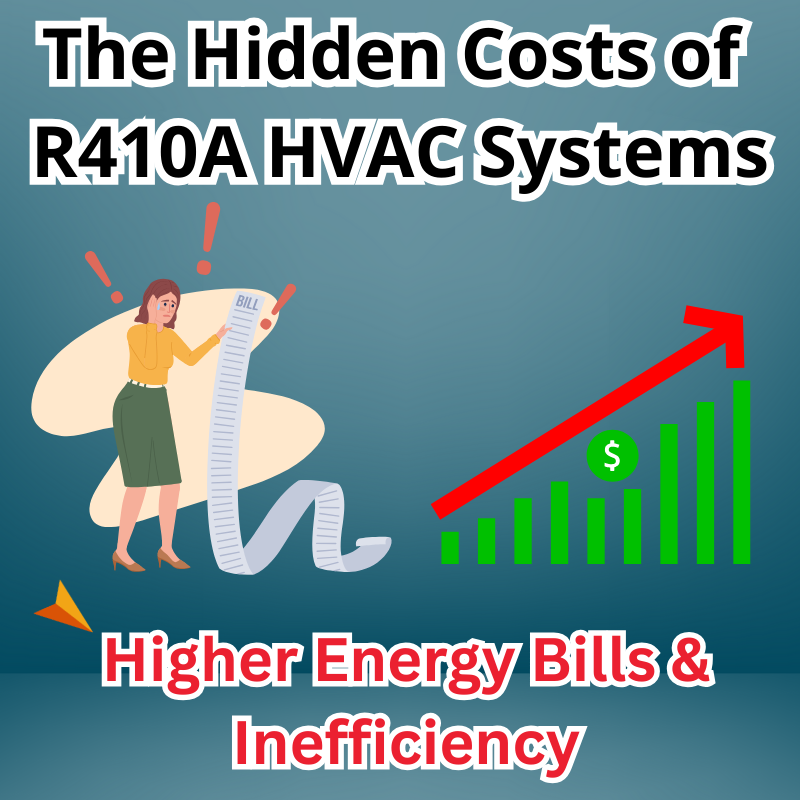When choosing an HVAC system, many homeowners and businesses have traditionally opted for systems that use R410A refrigerant, attracted by its availability and environmental advantages over older refrigerants like R22. While R410A offers better protection against ozone depletion, it carries hidden costs that can lead to higher energy bills and overall inefficiency. Understanding these drawbacks is crucial for making informed decisions about your HVAC system.
What is R410A?
R410A, commonly known under names like Puron, is a hydrofluorocarbon (HFC) that has become the standard refrigerant in residential and commercial air conditioning systems. Unlike its predecessor, R22, which was phased out due to its ozone-depleting properties, R410A is ozone-friendly. However, this refrigerant comes with its own challenges, particularly in terms of energy efficiency and operational costs.

Discover Top-Grade Air Conditioners: View Our Products Today
One major issue with R410A is its impact on energy efficiency. Although R410A is better for the ozone layer, it has a higher global warming potential (GWP) than R22, which means that if it leaks, it significantly contributes to greenhouse gas emissions.
Moreover, HVAC systems that use R410A typically operate at higher pressures than those using R22. This high-pressure operation can lead to increased wear and tear on system components, potentially shortening the system's overall lifespan. These higher pressures also often result in increased energy consumption, directly translating into higher energy bills for users.
The Real Cost: Higher Energy Bills
The higher operating pressures of R410A mean that HVAC systems require more energy to achieve the same cooling effect as older systems using R22. This is especially noticeable during peak cooling seasons, when your HVAC system is running continuously to maintain a comfortable indoor temperature. As a result, homeowners and businesses may experience a significant increase in their energy bills.
Additionally, the efficiency of an R410A system can degrade over time, especially if the system isn't properly maintained. Issues like dirty coils, clogged filters, and other common maintenance problems can further exacerbate the system's inefficiency, driving up energy costs even more.
Maintenance and Repair Costs
In addition to higher energy bills, R410A systems can be more expensive to maintain and repair. The high-pressure operation puts more stress on components like compressors, condensers, and evaporators, increasing the likelihood of breakdowns. When repairs are needed, the costs can be substantial, especially if specialized parts or refrigerant recharging is required.
As R410A systems age, the likelihood of refrigerant leaks increases. While R410A is less harmful to the ozone layer than R22, it is still a potent greenhouse gas. Leaks not only harm the environment but also necessitate costly repairs and refrigerant recharges.
The R32 Advantage: A Better Alternative
Given the hidden costs associated with R410A, it's worth considering alternative refrigerants like R32, which is quickly becoming the new standard in HVAC systems. R32 has a much lower GWP compared to R410A, making it a more environmentally responsible choice. Additionally, R32 systems operate at lower pressures, which can reduce energy consumption and decrease the wear and tear on system components.
Investing in a system that uses R32 may involve higher upfront costs, but the long-term savings on energy bills and maintenance can make it a worthwhile investment. Furthermore, choosing a refrigerant with a lower GWP is a responsible way to reduce your carbon footprint.
Future-Proofing Your HVAC System
While R410A played a crucial role in reducing ozone depletion, it comes with hidden costs that impact both your wallet and the environment. Higher energy bills, increased maintenance costs, and inefficiencies are all factors to consider when choosing an HVAC system. By exploring alternative refrigerants like R32 and newer technologies, you can reduce these hidden costs and enjoy a more efficient, cost-effective, and environmentally friendly HVAC system. If you’re looking for an R32 product coming soon we suggest the Goodman 3 Ton 16.4 SEER2 R32 Air Conditioner Condenser.







